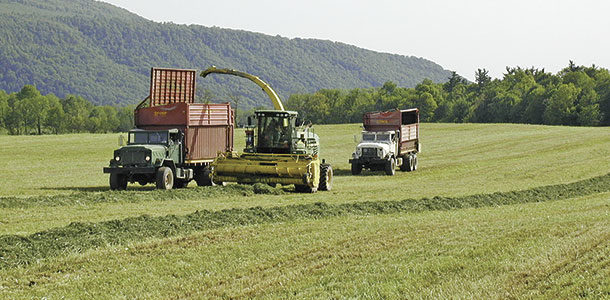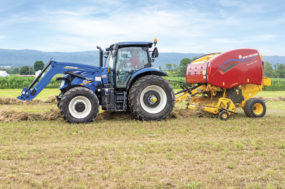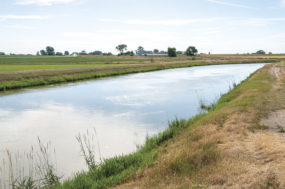Today’s economic situation and rapidly rising equipment costs may also limit each farm from owning expensive harvesting equipment.
But today, rather than pooling money and buying harvest equipment for the community, an individual within the community purchases the harvesting equipment and contracts with neighbors to harvest their forages.
The practice of several farms sharing harvesting equipment has been around for generations and has recently resurfaced as custom harvesting.
Just like there were issues that needed resolved when the community owned the thrasher – for example, how much does each farmer contribute to the initial purchase of the thrasher, which fields get harvested first, who pays for repairs – there are issues that need resolved when you are paying a custom harvester.
Too often, farmers look at the cost of custom harvesting and figure they can do it cheaper or better … and sometimes they can. However, farmers frequently underestimate the “true” cost of harvesting their own forages. Especially as increasing herd size requires more acres of forage.
I often hear farmers comment about the “high” custom rate for doing field work when many of them have no idea about the fixed costs associated with owning the equipment.
Several research studies have shown that the average farm pays about 20 percent more to do the work themselves than if they hired it done. Large and expensive harvesting equipment, used only a few days per year, is frequently unprofitable for one farm to own.
Plus, the additional overhead of owning harvest equipment could limit other investments (cows, new milking parlor, land) that could provide a larger financial return than the harvest equipment.
However, I don’t want to talk about the obvious costs and benefits that come with hiring a custom harvester. I want to focus on tangible costs, though equally real, a farmer should consider when deciding to use a custom harvester or not.
Forage quality
If you are last on the custom-harvest schedule, then the quality of your forage may suffer. But a survey of farms that used custom harvesters, compared to doing their own harvest, found that 41 percent had improved quality and 51 percent had no change in forage quality, leaving only 8 percent of the farms indicating they had lower quality when they used a custom harvester.
How is this possible? Rather than stretching forage harvest over a one- to two-week window as you might do with your own smaller and older equipment, a custom harvester can do it in one or two days. This rapid harvest means greater consistency in quality, which is very important to rumen microbial health, which in turn is very important to animal production.
Filling a silo over a two-week period provides a lot of opportunity for the forage in the unsealed silo to lose carbohydrates through respiration, heat, support mold growth and increase in the amount of “heat-damaged” protein.
On the other hand, filling a silo in one or two days leaves little time for these quality-lowering events to occur.
There have been several recent technology changes in harvesting equipment. For example, kernel processors, shredders, inoculant applicators, baler cutters and yield, quality and moisture monitors.
A custom harvester upgrades equipment more frequently and will likely have the latest and greatest equipment before an individual farmer, who has to wait until the current equipment wears out.
Agronomic issues
Larger harvesting equipment associated with custom harvesting drives on less of the field, which reduces the area of potential soil compaction. In addition, custom-harvesting equipment is generally equipped with tires that also minimize soil compaction.
Driving on the crowns of perennial forage plants damages the crown buds and reduces yield. In general, larger equipment reduces by half the crowns driven on and results in greater yield.
Delaying planting of corn while busy harvesting first-cut forages reduces potential corn yield and increases the risk of insufficient growing-degree days for the corn to reach maturity. Delayed silage corn maturity (delayed harvest) narrows the window for cover-crop planting in the fall.
Pesticide application or cultivation must be done in a relatively narrow time window for maximum effectiveness. Completing these jobs too late or too early because of forage harvesting is costly.
Rapid forage harvesting opens up a bigger window and more acres for manure hauling and better utilization of nutrients.
Time issues
Custom harvesting means fewer days will be spent harvesting and farmers can spend more time on other work or family. During forage harvest periods, other activities get pushed to the back burner (for example, cow care, other field work and family time).
What would farmers do if they suddenly had an extra two weeks each year?
Health issues
Working with older equipment that might break down can be very stressful. Health care professionals warn that stress is the leading cause of many ailments and can lead to heart attacks.
Adding frequent equipment failure to the already stressful job of forage harvesting does nothing to minimize work-related stress.
Most farm accidents occur when workers are stressed or tired. Fitting forage harvest around milking and everything else results in some very long work days and tired workers.
Knowing and planning for your harvest costs up front can reduce stress for you and your lender. Custom harvest costs can be negotiated, locked in and planned for months in advance.
Whereas breakdown of your own harvest equipment will not only cause delays in harvest but also unplanned expenses.
Deciding to use a custom forage harvester is a big decision for any farm. Before you dismiss the idea without due consideration, consider the “true” cost of doing it yourself. FG
PHOTO
Custom green chopping. Photo courtesy of staff.

-
Marvin Hall
- Professor of Forage Management
- Penn State University
- Email Marvin Hall












